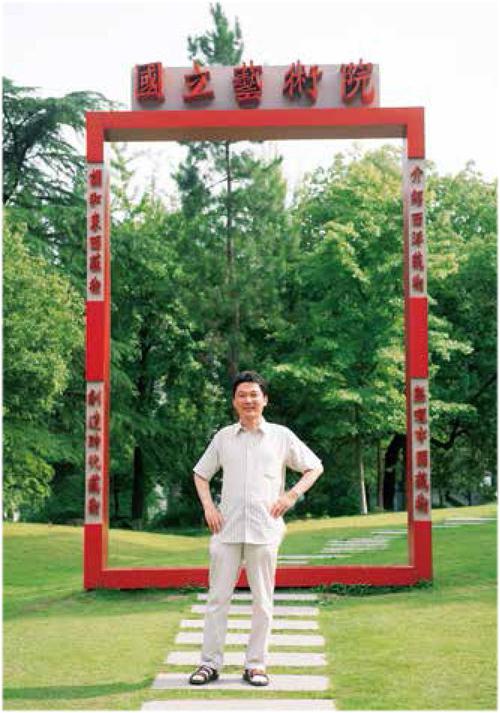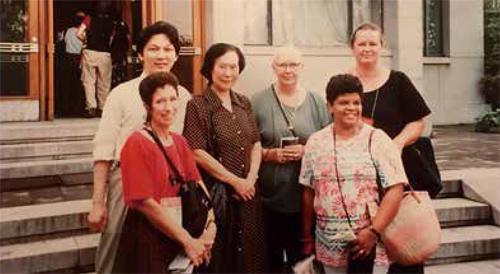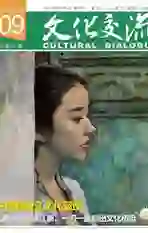任敏:30年致力于中外艺术交流
2018-09-06张奇志
张奇志
30年前,任敏应邀飞往美国罗得岛美术学院讲学,成为这所世界顶尖艺术学府第一位开讲《现当代中国艺术》的学者。令人惊叹的是,这门关于中国艺术的课,他在美国主流艺术学府连续讲了30年。
身为旧金山美术学院院长特别助理的任敏,今年春天带了多位欧美著名美术学院院长和艺术家,参加他的母校——中国美术学院90周年校庆的学术活动。笔者巧遇任敏教授,听他讲述过去30年从事中美艺术交流的故事。
带3500张中国艺术幻灯片赴美
1980年,任敏考进了浙江美术学院(中国美术学院的前身)油画系。在全国成千上万的考生中,那一年,油画系只招了10个学生。
按照任敏自己的话来说,这机会太难得了,所以在美院期间他拼命学习,“在美院度过的4年,可以说我没有给自己放过一天假,每个大年初一都是在画室里度过的。”一心学画之余,他还“无心插柳”种下了一颗中美艺术交流的“种子”。
在那个外语水平普遍不高的年代,任敏凭着扎实的英文功底,英语考了那一届的最高分——96分。因此,入学初他就被学校外事处拉去做业余翻译,时常接待美国来的客人,其中既有艺术学院的院长,也有著名的艺术家。
在与来自美国的“艺术大咖”面对面的交流中,他发现他们对中国艺术的了解非常有限。美国大学课堂上讲授的中国艺术,基本上止于清代,几乎完全不知道中国艺术发展的现状。
由此他就萌生了一个想法:“有朝一日,我要向美国艺术界及对中国艺术和文化感兴趣的外国人,介绍真正的中国艺术,以及中国艺术目前最新的发展情况。”
美术学院毕业后,他为此整整准备了三年。在美术馆、在艺术家的工作室里,到处搜集辛亥革命后中国艺术发展的资料,并把它们做成幻灯片。
一个胶卷能放进36张幻灯片。他把自己的大部分工资收入“搭进去”,再加上朋友的赞助,搞了近100个胶卷,共制作了3500张幻灯片,并分门别类组成20个专题。
1987年12月底,任敏在上海参加了首届“中国油画展”,并在现场搜集资料,完成了最后一个胶卷的制作。第二天,带着这批“宝贝”幻灯片,还有浙江美院赠送的陆俨少等艺术家创作示范的12盘录像带,任敏登上赴美的飞机,应邀前往美国罗得岛美术学院和旧金山美术学院讲学。
1988年1月,迈进罗得岛美术学院的任敏,成了这所艺术学府建院111年后首位专题讲授《现当代中国艺术》的中国大陆学者。
带100位美国女艺术家访华
果然,凭着精心制作的幻灯片,任敏以图文并茂的方式讲述中国现当代艺术发展的课程引起不小轰动。美国主流艺术学院纷纷向他发出邀请。他相继到布朗大学、纽约视觉艺术学院、费城摩尔艺术与设计学院等学校举办讲座。第二年,又到旧金山美术学院开设课程。
这些年来,他先后促成了众多中美艺术学院开展交流合作,包括推动中央美院、中国美院、鲁迅美院和上海美院与美国主要艺术院校之间进行双方院长互访、签订校际交流合作协议。
此外,他还安排中国学者到美国访学进修,组织美国艺术家和学生来中国写生和采风。这个过程当中,他不取分文,个人所有往返机票都是自己掏钱购买,回到杭州就住在自己家里。
最令他难忘的,是1995年的“中国艺术之旅”。那一年,世界妇女大会首次在中国举办。当时,全美妇女艺术家协会计划派出一个100人的代表团到北京参会。协会的负责人正愁不知道该如何安排这场规模空前的民间艺术访问,无意中找到了任敏,便委托他策划这次“中国艺术之旅”。
当时已在旧金山美术学院任职的任敏,为了让这次民间艺术访问顺利成行,主动请了一个学期的假,还请了两位同事帮忙,一起全程策划安排这次活动。
“累坏了!”提起那次经历任敏至今还“心有余悸”,“我在1994年接下这个活动,提前一年就开始了准备工作。”
“那时还没有手机和网络,打国际长途电话也很贵,主要是通过发传真在中美两国之间进行联系。使馆、宾馆、旅行社,机场、车站、大巴车,每个环节都要反复确认。因为时差的关系,工作经常得昼夜颠倒。”任敏说。
这批参加访华的全美妇女艺术家协会代表,基本都是各个艺术大学的教授、美术馆或博物馆的馆长、艺术基金会的总裁等。她们是女艺术家中的佼佼者,在各自专业领域都很有成就。在那个年代,要给100个美国女艺术家安排一次可實施并令各方满意的中国行,显然是一项高难度的任务。
直到1995年9月,第四次联合国世界妇女大会正式召开,百名美国女艺术家如期抵达北京,任敏才暂时松了一口气。大会结束后,他又马不停蹄,把这些女艺术家分为3组,分头访问那些“活”在中国传统诗歌和绘画里的艺术圣地——西安、敦煌、桂林、杭州、黄山……通过实地走访,这些口味“挑剔”的女艺术家实实在在地感受到了中国文化的独特魅力。
上世纪90年代以来,任敏在教书之余,几乎每年都要组织一个美国艺术家团队到中国来,探访中国的美术学院,拜访中国的艺术家,接触中国艺术。而他们带着收获和满足回到美国后,就成了传递中国艺术的“星星之火”。
30年坚持在美讲授中国艺术
上世纪90年代,任敏在美国绘画创作和开课的过程中,接触到在美国当时流行的一种新型绘画颜料——丙烯。它具有色彩鲜艳、化学性质稳定、耐久性强等多种特点。威廉·德·库宁等艺术家广泛使用丙烯进行油画创作,并逐渐开创了抽象表现主义。
然而同期的中国油画,绘画工具、颜色材料媒介等的制作和绘画技术还很落后,仍基本停留在美国上世纪三四十年代的水平。为了填补国内丙烯绘画的空白,作为油画和丙烯画材颜料技法的专家,任敏利用假期回国,多次在中国美院、中央美院和四川美院等高校无偿为国内的艺术教师们开设技术研习示范班,并下决心把美国最先进的艺术和材料带回国内。
回到美国后,他花了半年的时间,找了6家不同的丙烯生产厂家,自费跑去参观,并一家一家地跟他们去谈,跟厂家打“前景牌”:“中国艺术家现在需要这个东西,不过暂时还没有钱买。中国是一个很大的市场,如果你们把丙烯材料免费提供给我们一部分,就可以借此去做个展示和推广,将赢得未来广阔的市场……”
在任敏的“软磨硬泡”下,6家工厂全都给他提供了丙烯材料,价值近5万美元。中国艺术家们终于免费用上了西方的新材料,丙烯绘画技术也得到了长足的发展。
除了自己搞艺术创作和开设专业绘画课,任敏还一直坚持为美国学生讲授《现当代中国艺术》课,这一讲就是整整30年,直接听过课的学生有近2000人。
因为是通识课,非艺术专业的学生,只要对中国文化感兴趣,都可以自由选这门课。可以说,30年来,这门課在一大批医生、律师这样的美国社会主流群体当中,悄悄埋下了一颗中国文化的种子。
30年来,任敏越来越强烈地感受到文化的力量是最强大的。一个更大的梦想在心里激荡着,他想在中国这样一个大的文化艺术平台上,集世界艺术界之大成,创办世界最高水准的艺术教育品牌。
母校给了他最有力的响应。2017年9月,一个由任敏倡导的“当代艺术国际硕士研究生班”在中国美术学院启动。这是全英文授课的硕士项目,面向全球招生,学制3年。教师团队由来自中美欧的传统美术、公共艺术、设计、戏剧与艺术表演等学科的顶级学者、艺术家和策展人组成。首届招录的13名本科毕业生,来自罗得岛美院、旧金山美院等国际知名艺术院校。
“中国在过去30年时间里发生了很大的变化,不仅改革着自己,同时也在改变着世界。”在开班仪式上,美国卡罗来纳大学艺术学院教授Michael Grady希望,这个国际硕士研究生班的学员不是游学者,而是文化和艺术的传播者,要担负起促进中西方文化交流与合作的责任。
“只要我们脚踏实地,假以时日,一定能打造世界级的艺术教育品牌。”任敏的话音不高,口气却异常坚定。
Dedicated to Introducing Chinese Art to the West
By Zhang Qizhi
In 1980, Ren Min was one of the ten students recruited by the oil painting department of Zhejiang Academy of Fine Arts based in Hangzhou, which was the predecessor of the present-day China Academy of Art. He treasured the rare opportunity so tightfistedly that he worked hard and didnt give him a day off during the four years at the academy. In addition to the rare talent he had, he also showed a rare genius in English. He had got the highest score in the national college-level entrance examination of all the freshmen recruited by the academy that year. For this reason, he was often asked to serve as an interpreter in the academys exchange programs. This engagement with foreign artists and art educators gave him an insight into the reality of cultural exchanges between China and America: art circles of the west had a very limited knowledge of the modern and contemporary Chinese art. He was under the impression that all these art teachers knew well were limited to the Qing Dynasty (1644-1911) and before and that they knew almost nothing after the Qing.
Ren began to dream that one day he would give lectures on Chinese art and culture to American artists and the public.
He prepared himself toward the dream for three years after his graduation from the academy. He built up his collection on Chinese art after the 1911 Revolution and made slides. The salary he earned went most into the slides. His friends helped financially. Altogether he made 3,500 slides in 20 lectures.
In December 1987, Ren Min attended the First National Oil Painting Exhibition in Shanghai and collected an adequate amount of information. The next day, he flew to America with all the slides and 12 reels of VHS video tapes in which Lu Yanshao and other contemporary masters demonstrated the way they created paintings in the traditional Chinese style. Ren Min was to give lectures at Rhode Island School of Design, one of the most prestigious art institutions in America.
His lectures on Chinese modern art were unprecedented at the institute founded in 1877. These lectures opened American art circles to the evolution of art in China in the 20th century. Ren Min caused a sensation. He was invited to give lectures at Brown University, School of Visual Arts of New York City, and Moore College of Art and Design. In 1989, he lectured at San Francisco Art Institute.
Ren Min has played an active role in promoting academic and artistic exchanges between China and America over the past decades. Since the 1990s, he has organized American artists to visit China annually. In 1994, he was commissioned by National Association of Women Artists, an American art organization, to make arrangements for a 100-member NAWA delegation to tour China after its participation in the United Nations World Conference on Women to be held in Beijing in September 1995. In that pre-internet era, he needed to take off a whole semester to make all the arrangements with assistance of two assistants. He is the man behind some exchange programs between mainstream Chinese art academies and their American counterparts.
He has been teaching about modern Chinese art in America for thirty years. In September 2017, an international graduate course on modern art was launched at China Academy of Art in Hangzhou. Ren Min is one of the main drivers behind the course. The three-year graduate course is taught in English and students are from all over the world. In 2017, 13 international students started their graduate studies on traditional art, public art, design, theater, artistic performances.
“Over the past 30 years, China has seen tremendous changes, which are transforming the country as well as the world. We must work hard in a down-to-earth spirit. It takes time for us to create a world-class art education brand,” said Ren Min determinedly.
